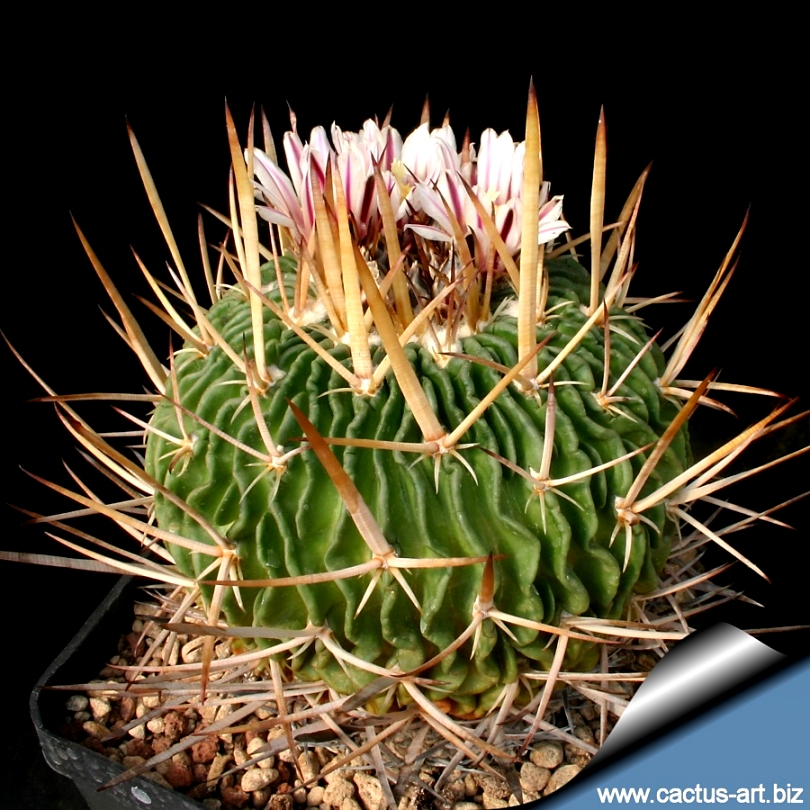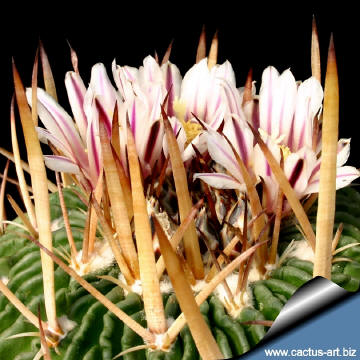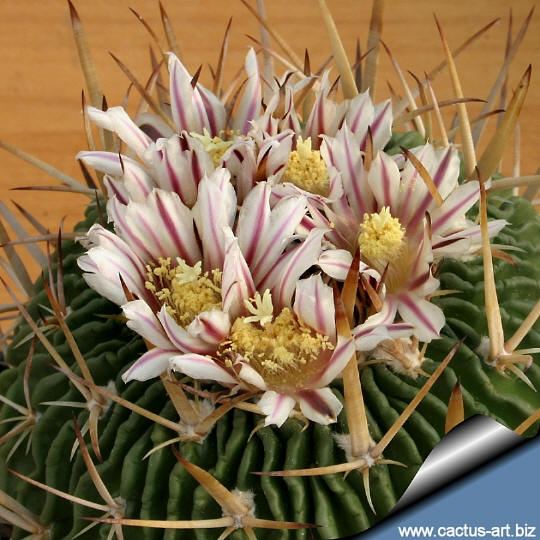|
|
|

The upper spine spines are long flat and straight.
|

|
Description:
Usually solitary round or flat
Stem: Up to 7 cm broad, 4 cm highly; Vertex woolly;
Ribs: approx.. 60, rather hard;
Spines: Ferocious-looking, Radials 2-4, to approx 5-20 (30) mm
long, light brown; with one stronger upper one approx. 1 to 4
(5,5) cm long, 1.5-3 mm wide, yellowish-white-grey with darker tip;
Bloom: 2.5 cm broad; tepals inside purely white, with violet
centre strip.
Propagation: seeds,
cuttings, or offsets (if available). Allow cuttings to dry for a few
days before placing in a rooting medium. This permits the cut surface to
heal, or callus. The callus helps prevent rotting when the cutting is
placed in the rooting material. |
|
Photo of
conspecific taxa, varieties, forms and cultivars of
plants belonging to the
echinofossulocactus crispatus
complex
(This
Taxon has lots of
synonyms (like most Echinofossulocactus) whit several controversial
varieties and subspecies):
|
|


Advertising
|
|
|
|
|
Family:
Cactaceae (Cactus
Family)
Scientific name:
Echinofossulocactus kellerinus Krainz 1946
-
Echinofossulocactus crispatus (A. P. de Candolle) Lawrence
1841
- Stenocactus kellerianus nov.
comb. ined.
- Stenocactus crispatus f. kellerianus (Krainz) P.V. Heath 1992
|
Other
Synonyms (of E. crispatus):
- Echinofossulocactus
crispatus (A. P. de Candolle) Lawrence 1841
= Ferocactus crispatus (A. P. de Candolle) N. P. Taylor 1980
= Echinocactus crispatus
A. P. de Candolle 1828
- Echinofossulocactus
dichroacanthus (Martius ex Pfeiffer) Britton et Rose 1922
= Echinocactus dichroacanthus Martius ex Pfeiffer 1837
= Stenocactus dichroacanthus (Martius ex Pfeiffer) A. Berger ex
Backeberg 1935
-
Echinofossulocactus lancifer (A. Dietrich) Britton et Rose
1922
= Echinocactus lancifer A. Dietrich 1839
= Stenocactus lancifer (A. Dietrich) A. Berger ex Backeberg et
F. M. Knuth 1929
-
Echinofossulocactus arrigens
(Link ex A. Dietrich) Britton et Rose 1922
= Echinocactus arrigens Link ex A. Dietrich 1840
= Stenocactus arrigens (Link ex A. Dietrich) A. Berger 1929
-
Echinofossulocactus lamelosus
(A. Dietrich) Britton et Rose 1922
= Echinocactus lamelosus A. Dietrich 1847
= Stenocactus lamelosus (A. Dietrich) A. Berger 1929
- Echinocactus flexispinus
Salm-Dyck 1849
= Echinofossulocactus flexispinus (Salm-Dyck) Bravo 1969
- Echinocactus violaciflorus
Quehl 1912
= Echinofossulocactus violaciflorus (Quehl) Britton et Rose
1922
= Brittonrosea violaciflora
= Echinocactus violaciflorus
= Stenocactus dichroacanthus var. violaciflorus
= Stenocactus violaciflorus,
- Echinofossulocactus confusus
Britton et Rose 1922
= Stenocactus confusus
= Brittonrosea confusa
- Echinofossulocactus guerraianus
Backeberg 1942
- Echinofossulocactus kelleranus (kellerianus)
Krainz 1946
- Echinofossulocactus
multiareolatus Bravo 1960
|
|
|
|

Culture: Easy to to
care and flower. No absolute schedule can be given
for watering as various factors (Soil mixture, containers,
drainage, temperature, size of plant) influence water use, so - as
a general rule - the soil should be thoroughly wetted at each watering
during the active growing season (spring and summer), water when the top
1,5- 2 cm of soil feels dry to the finger. Do not soak the soil during
the dormant period. Be careful, excessive watering can make root and/or
stem to rots. Make sure there is good air circulation between plants.
Good drainage is essential along good moisture retention properties and
adequate nutrients availability.
Require bright sunlight to grow well.
Dormant plants do best at temperatures from 5-10°C (but will tolerate
-5° for short periods). The cooler temperatures develop sturdier plants
and encourage the formation of flower buds.
|
|